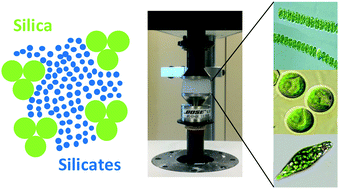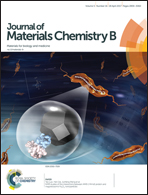The physics and chemistry of silica-in-silicates nanocomposite hydrogels and their phycocompatibility†
Abstract
Silicates-in-silica nanocomposite hydrogels obtained from sodium silicates/colloidal silica mixtures have previously been found to be useful for bacterial encapsulation. However the extension of synthesis conditions and the understanding of their impact on the silica matrix would widen the applicability of this process in terms of encapsulated organisms and the host properties. Here the influence of silicates and the colloidal silica concentration as well as pH conditions on the gel time, the optical properties, the structural and mechanical properties of silica matrices was studied. We show that gel formation is driven by silicate condensation but that the aggregation of silica colloids also has a major influence on the transparency and structure of the nanocomposites. Three different photosynthetic organisms, cyanobacteria Anabaena flos-aquae and two microalgae Chorella vulgaris and Euglena gracilis, were used as probes of the phycocompatibility of the process. The three organisms were highly sensitive to the silicate concentration, which impacts both the gelation time and ionic strength conditions. The Ludox content was crucial for cyanobacteria as it strongly impacts the Young’s modulus of the matrices. The detrimental effect of acidic pH on cell suspension was compensated by the silica network. Overall, it is now possible to select optimal encapsulation conditions based on the physiology of the targeted cells, opening wide perspectives for the design of biosensors and bioreactors.



 Please wait while we load your content...
Please wait while we load your content...